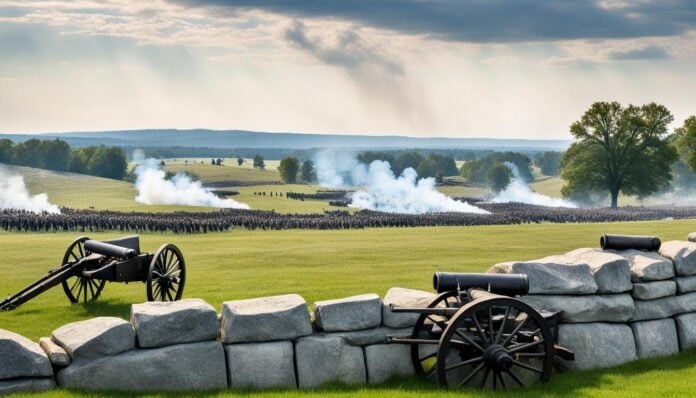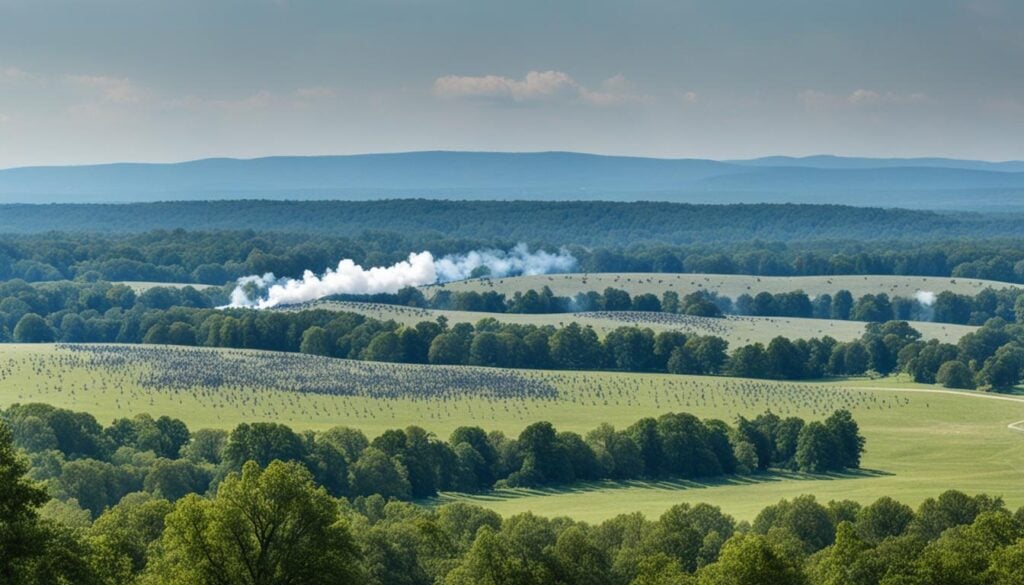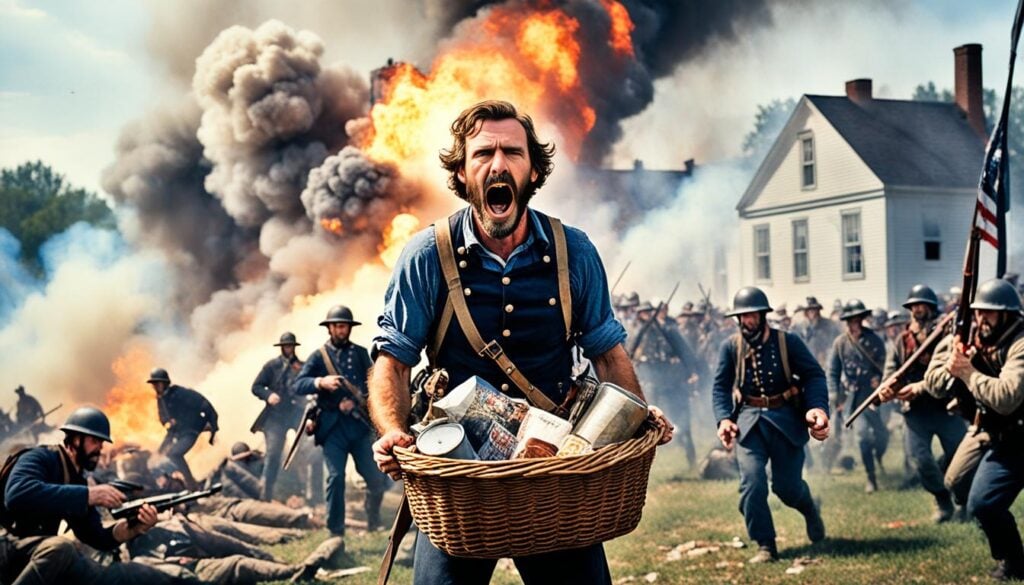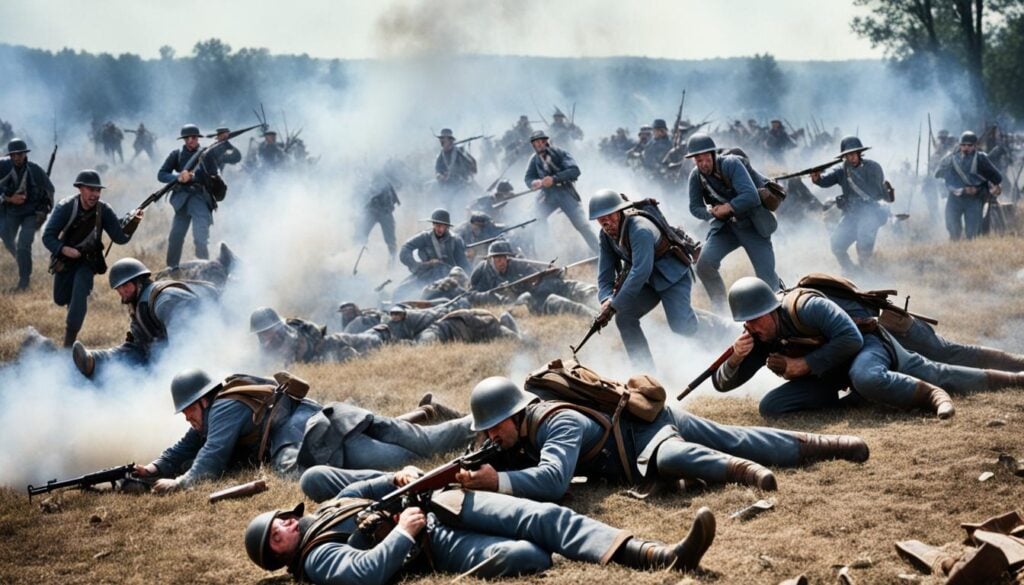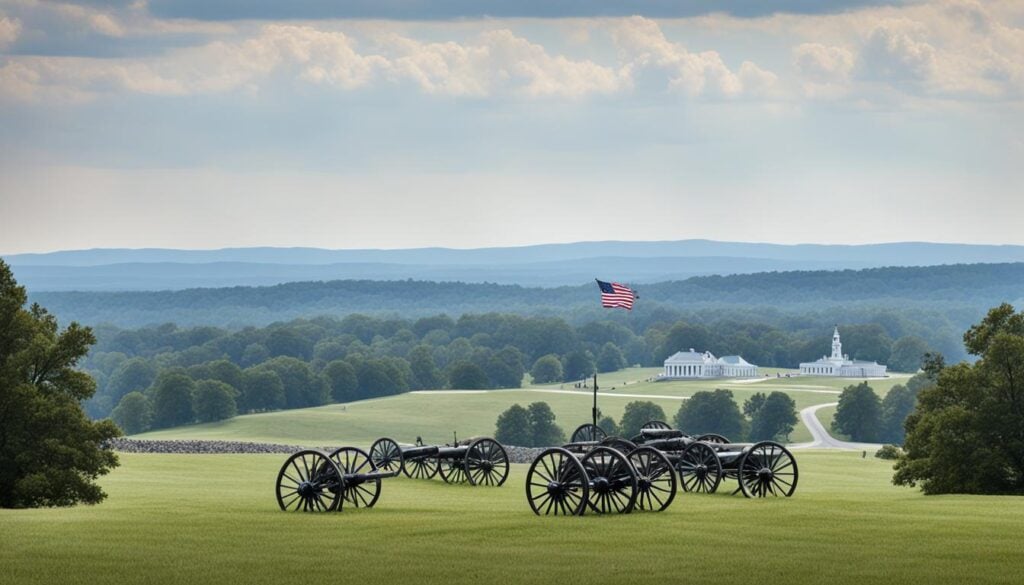Think you know everything about the infamous Battle of Gettysburg? Prepare to be surprised! This piece will share facts you probably didn’t know.
Imagine learning about the battlefield history from a new perspective. We will explore surprising elements, such as unusual strategies and the impact on civilians. This article will help you understand this crucial event in American history even better.
Get ready to look at the Battle of Gettysburg in a different light. We’re going to uncover secrets that change how we see this battle. Are you excited to learn the unknown tales? Let’s start our exploration of Gettysburg’s hidden history.
The Importance of Gettysburg
Strategic Significance
The Battle of Gettysburg took place during the American Civil War. It occurred from July 1st to July 3rd, 1863, in Gettysburg, Pennsylvania. This battle changed the war’s direction and decided if the Union would stand.
Turning Point in the War
Gettysburg was a turning point for the war. Before it, the Confederates, led by General Robert E. Lee, had won many battles in the East. Yet, their loss at Gettysburg was a big blow, stopping their push North. This loss weakened the Confederacy and lifted Union soldiers’ spirits.
Impact on the North and South
Over 50,000 soldiers were either killed, hurt, or captured in this battle. The Union won, and this victory was key for the North. It gave Northerners hope and crushed the South’s dreams of getting help from other countries.
“The Battle of Gettysburg was a defining moment in the Civil War. Its impact reverberated across the country and changed the course of history.”
Preserving the Union
The Union’s win at Gettysburg was crucial for keeping the U.S. together. A different outcome might have led to the Confederates winning the war. This victory ensured America would remain one nation.
Legacy and Commemoration
Gettysburg had a lasting impact on the U.S. Today, the Gettysburg National Military Park stands as a place to honor soldiers from both sides. People can visit, see reenactments, and pay respects at the many monuments there.
Gettysburg War Details
| Gettysburg Battle Facts | Details |
|---|---|
| Date | July 1-3, 1863 |
| Location | Gettysburg, Pennsylvania |
| Commanders | Union: General George G. Meade Confederacy: General Robert E. Lee |
| Outcome | Union victory |
| Casualties | Union: Approximately 23,000 Confederacy: Approximately 28,000 |
| Significance | Pivotal point in the Civil War; turning point in favor of the Union; thwarted Confederate ambitions |
Gettysburg provides interesting details about the war, its leaders, and the sacrifices the soldiers made.
The Three-Day Battle
The Battle of Gettysburg was a major event during the Civil War, lasting from July 1 to 3, 1863. It happened in Gettysburg, Pennsylvania. This battle is a key point in American history, changing the war’s direction.
On July 1, General Robert E. Lee led the Confederate Army against General George G. Meade’s Union forces. The fight began in the town’s northwest and went south. Although the Confederates had some success early on, the Union’s hold on key areas like Cemetery Hill turned the tide.
July 2 brought more battles as both sides fought for advantage. The Confederates tried to break the Union’s left flank by attacking places like Little Round Top. Despite intense fighting, the Union stood strong.
July 3 showcased Pickett’s Charge, where General Lee aimed to break the Union center. 12,000 Confederate soldiers marched against heavy Union defenses on Cemetery Ridge. The Union’s fierce defense and artillery caused severe losses to the Confederates, forcing them to retreat.
The Union’s victory at Gettysburg was key. It was the first major loss for General Lee and significantly affected the Civil War’s outcome. The battle saw about 51,000 soldiers killed, wounded, or missing.
Learning about the Battle of Gettysburg shows us the sacrifices both sides made. It’s a lesson in leadership, strategy, and the costs of war.
| Date | Key Events |
|---|---|
| July 1 | Confederates win early battles but miss key areas. |
| July 2 | Fierce fighting, with the Union holding important points. |
| July 3 | The unsuccessful Pickett’s Charge leads to heavy Confederate losses and retreat. |
The Role of Civilians
The Battle of Gettysburg was a turning point in American history. It taught us a lot about courage and unity. Civilians were key in all of this. They did more than people usually remember. Here’s some important stuff about what they did during the Battle of Gettysburg:
1. Aid to the Wounded
In the middle of the battle’s chaos, some brave folks helped the wounded. People living nearby, even women and children, turned their homes into hospitals. They gave care and comfort to the hurt. Their efforts saved many lives and brought hope during dark times.
2. Gathering and Sharing Intelligence
Villagers and shopkeepers played a vital part in sharing important news. They watched the enemy and passed on what they saw. This information was crucial for the Union. It helped them make better choices, which affected the battle’s end.
3. Supporting the Troops
During the fighting, the community stood by their soldiers. They offered food, water, and more. This support lifted the soldiers’ spirits. It gave them the power to keep fighting.
This part of the Battle of Gettysburg often goes unnoticed. But, what these regular people did was amazing. Their bravery and kindness are a big part of the battle’s story.
Unconventional Tactics
In the Battle of Gettysburg, both sides used unusual strategies. These tactics made the fight more complicated and intense.
The Union built many defenses under General George G. Meade. These defenses were key in protecting against attacks by the Confederates. They showed how important it is to be ready to defend.
Pickett’s Charge was a risky move by Confederate General Robert E. Lee. He sent soldiers to attack the Union’s center. Even though they made progress, the attack failed. This showed such direct assaults have their dangers.
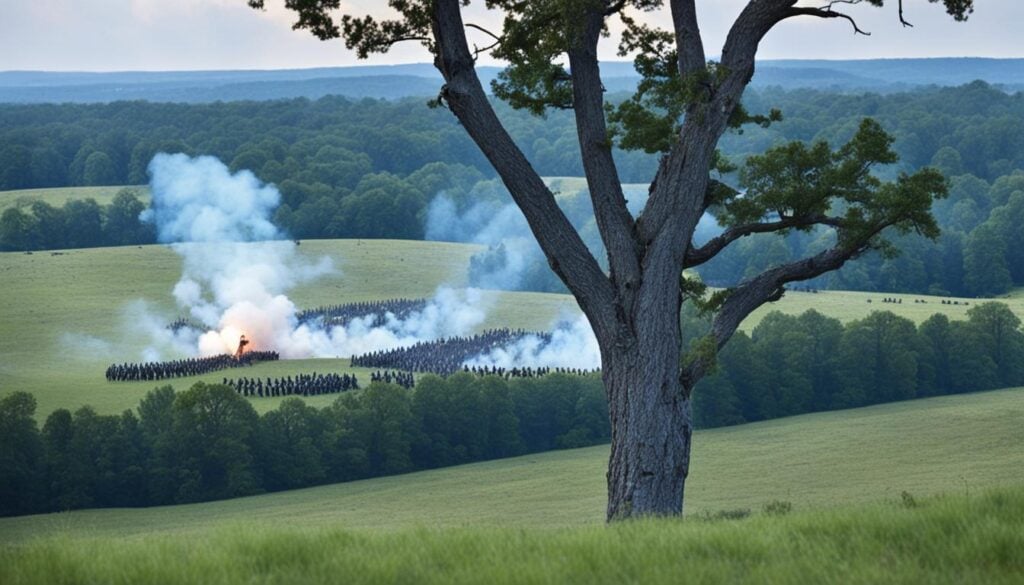
Artillery, or cannons, played a big part in the battle. They were used for long and short-range attacks. Their fire made the battlefield chaotic and destructive.
On the Confederate side, General J.E.B. Stuart made clever moves with the cavalry. His troops tried to cut off the Union’s supplies and ways to communicate. This showed how being fast and tricky could help in war.
| Unconventional Tactics | Impact on Gettysburg |
|---|---|
| Strategic use of entrenchments | Provided crucial defensive positions |
| Pickett’s Charge | Highlighted risks of frontal assaults |
| Intensive use of artillery | Created a chaotic and destructive atmosphere on the battlefield |
| Unconventional cavalry tactics | Disrupted Union supply lines and communication networks |
The tactics used at Gettysburg show how smart and flexible the forces were. They tried new things to win in such an important battle, changing its course forever.
Unforgettable Moments
The Battle of Gettysburg had many moments that changed history. Impactful speeches and brave acts shape our understanding of that time. These moments continue to interest people in Gettysburg’s battle history.
Famous Gettysburg Address
President Abraham Lincoln gave a famous speech at Gettysburg. He spoke on November 19, 1863, at the Soldiers’ National Cemetery. His speech honored the fallen soldiers and their bravery. The Gettysburg Address is a key part of American history.
Extraordinary Acts of Bravery
Both Union and Confederate soldiers showed bravery at Gettysburg. Confederate soldier William Mahone is a great example. He led a bold charge against the Union at the Battle of the Crater. His actions showed the fight and spirit during the Gettysburg battle.
“The men were swept away; the tide was irresistible, and on we went, sweeping the enemy from our front.”
John Burns, the Civilian Fighter
John Burns was 70 but joined the Union troops at Gettysburg. He fought until injured several times. His bravery inspired those around him. He showed great courage and dedication in the battle.
| Name | Affiliation | Role |
|---|---|---|
| William Mahone | Confederate | Brigadier General |
| John Burns | Union | Civilian Fighter |
The Battle of Gettysburg had many outstanding moments. Lincoln’s address, Mahone and Burns’ bravery are just a few. They all play a key role in the battle’s ongoing importance in American history.
Impact on Civilian Life
The Battle of Gettysburg changed the area and its people forever. The war left many local buildings destroyed and a lot of people hurt. Civilians faced tough times after the battle, rebuilding their homes and their lives.
Humanitarian Crisis and Rebuilding Efforts
Homes, shops, and roads were all ruined by the war. Many people had nowhere to live. The battle brought a lot of hurt soldiers who needed care, making things even harder for locals.
Despite this, the people stood strong. They helped each other, giving out food and shelter. These efforts helped the town, and its people, recover from the war’s bad times.
Emotional Impact and the Healing Process
The Battle of Gettysburg brought a lot of pain and fear. People who saw it or lived through it were deeply scarred. This battle’s memory is hard for them even today.
Gettysburg became a town of sorrow… All was confusion and agony. I have seen many, very many scenes of sorrow, and seen them with a heart full of sorrow; but I have never seen any equal to what I saw here yesterday.
—Josephine Miller, eyewitness to the aftermath of the battle
Yet, with time, the area started to heal. Memorials were built to remember what happened. These places help people and cities remember the importance of coming together, especially in hard times.
Long-Lasting Legacy
The Battle of Gettysburg had a lasting effect on the people’s lives. Their hard work and unity during difficult times set a great example. Today, Gettysburg is a reminder of how strong people can be, even after tragic events.
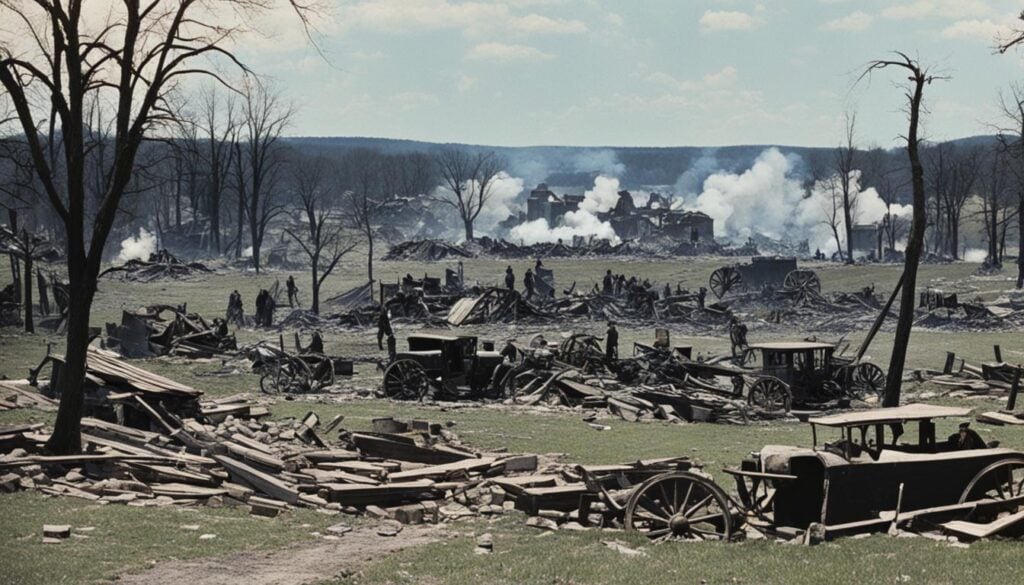
Legacy and Commemoration
The Battle of Gettysburg is a key point in American history. It left a powerful legacy still remembered today. Its impact goes far beyond the Civil War, shaping our nation’s story.
Gettysburg National Military Park
The Gettysburg National Military Park is a major tribute to the battle. Covering over 6,000 acres, it honors the bravery and sacrifice shown. Here, you can see places like Devil’s Den and Little Round Top, where the battle’s crucial moments happened. The park also has museums and educational programs. These teach us about the battle and its meaning.
Annual Reenactments and Memorial Ceremonies
Every year, people come together to remember the Battle of Gettysburg. This includes reenactments and memorial services. They let visitors feel what the battle might have been like. From musket sounds to soldiers walking in lines, it aims to recreate the past. This honors the soldiers who bravely fought and lost their lives.
Historical Preservation Efforts
The story of the Gettysburg battle is also protected by many. They work to keep the battle’s sites intact for future learning. Activities include archaeology and site restoration. These efforts are crucial in preserving the battlefield’s historical value.
Education and Scholarly Research
Many scholars and researchers study the Battle of Gettysburg. They aim to understand its complexities and find new facts. Lessons at academic schools dig deep into the battle’s history. They use old documents and eyewitness reports. Thanks to ongoing study, our insight into Gettysburg keeps growing.
Honoring the Battle of Gettysburg celebrates those who fought. It also highlights the battle’s lasting effects on our country. From park visits to studying academically, its memory guides us. It reminds us of our shared past and encourages us for the future.
Conclusion
This article has shared some hidden truths about the Battle of Gettysburg. We’ve learned about stories and details not often told. The battle’s influence on the war and daily life back then is huge.
Even now, the legacy of Gettysburg remains important. It shows us the sacrifices and lessons from that critical time in America’s past.

































